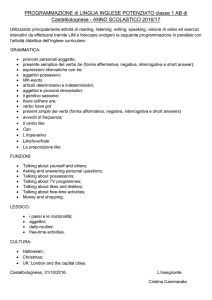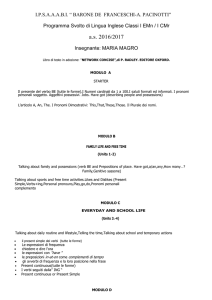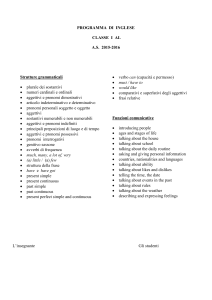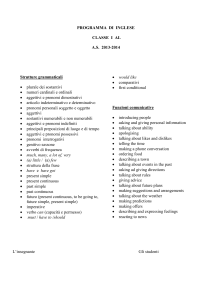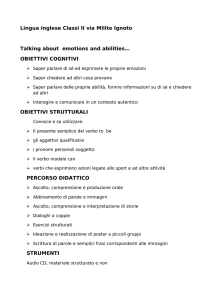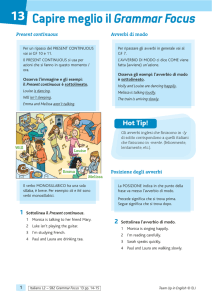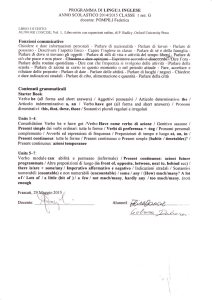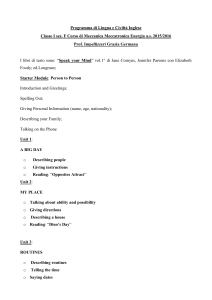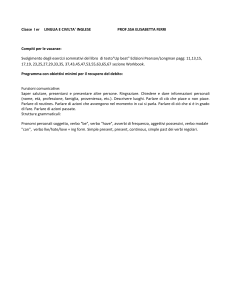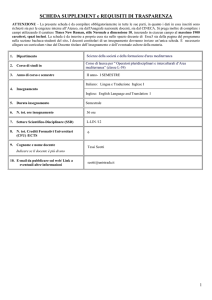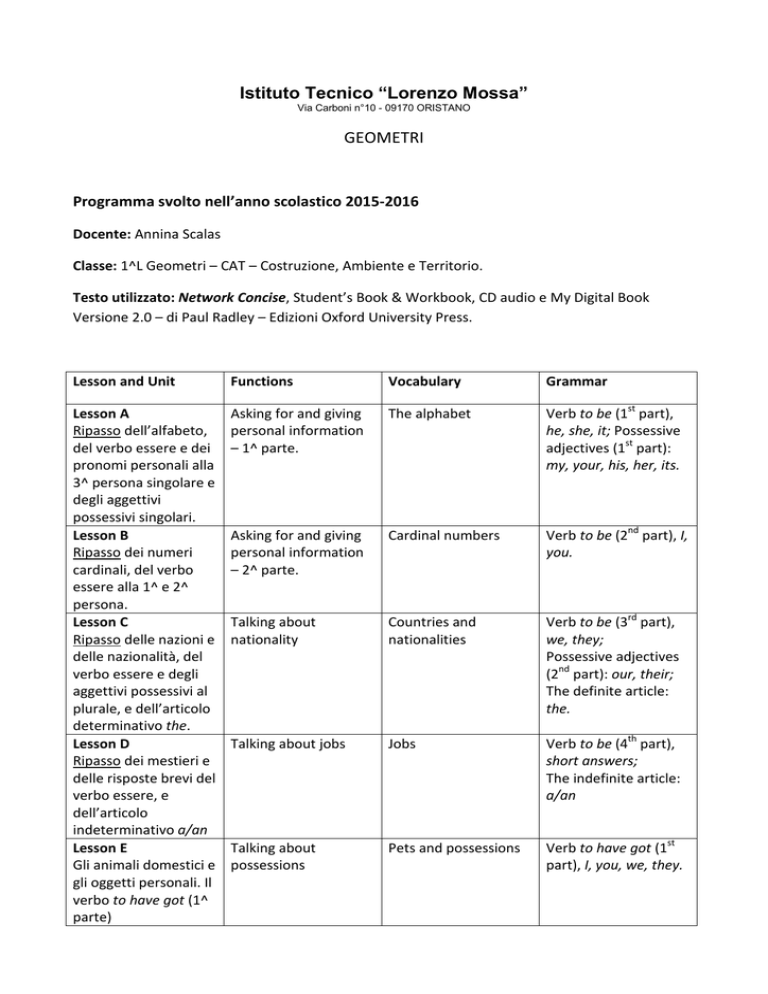
Istituto Tecnico “Lorenzo Mossa”
Via Carboni n°10 - 09170 ORISTANO
GEOMETRI
Programma svolto nell’anno scolastico 2015-2016
Docente: Annina Scalas
Classe: 1^L Geometri – CAT – Costruzione, Ambiente e Territorio.
Testo utilizzato: Network Concise, Student’s Book & Workbook, CD audio e My Digital Book
Versione 2.0 – di Paul Radley – Edizioni Oxford University Press.
Lesson and Unit
Functions
Vocabulary
Grammar
Lesson A
Ripasso dell’alfabeto,
del verbo essere e dei
pronomi personali alla
3^ persona singolare e
degli aggettivi
possessivi singolari.
Lesson B
Ripasso dei numeri
cardinali, del verbo
essere alla 1^ e 2^
persona.
Lesson C
Ripasso delle nazioni e
delle nazionalità, del
verbo essere e degli
aggettivi possessivi al
plurale, e dell’articolo
determinativo the.
Lesson D
Ripasso dei mestieri e
delle risposte brevi del
verbo essere, e
dell’articolo
indeterminativo a/an
Lesson E
Gli animali domestici e
gli oggetti personali. Il
verbo to have got (1^
parte)
Asking for and giving
personal information
– 1^ parte.
The alphabet
Verb to be (1st part),
he, she, it; Possessive
adjectives (1st part):
my, your, his, her, its.
Asking for and giving
personal information
– 2^ parte.
Cardinal numbers
Verb to be (2nd part), I,
you.
Talking about
nationality
Countries and
nationalities
Verb to be (3rd part),
we, they;
Possessive adjectives
(2nd part): our, their;
The definite article:
the.
Talking about jobs
Jobs
Verb to be (4th part),
short answers;
The indefinite article:
a/an
Talking about
possessions
Pets and possessions
Verb to have got (1st
part), I, you, we, they.
Lesson F
Gli aggettivi usati nelle
descrizioni delle
persone. Il verbo to
have got (2^ parte)
Lesson G
I pronomi dimostrativi
e il plurale dei
sostantivi.
Unit 1- Family life
I membri della
famiglia, il verbo to be
e le preposizioni di
luogo (1^parte), il
genitivo sassone, il
verbo to have got,
a/an/ How many….?
any
Unit 2- Free time
Il presente indicativo
dei verbi (1^ parte), i
verbi + -ing, i pronomi
personali
complemento, le
espressioni con i verbi
to play, to go, to do.
Unit 3- Everyday life
Il presente indicativo
dei verbi (2^ parte),
descrizione delle
attività di ogni giorno.
L’orario, gli avverbi e
le espressioni di
frequenza, le
preposizioni at, on, in,
le espressioni con il
verbo to have.
Unit 4- School life
Le materie scolastiche,
il Present continuous
(1^ e 2^ parte);
L’utilizzo del Present
Continuous o del
Present simple,
I verbi di stato.
Unit 5- Difficult days
I numeri ordinali, l
mesi dell’anno e le
Describing appearance Describing people
Verb to have got (2nd
part), he, she, it.
Understanding
classroom language
Classroom objects
Talking about family;
Talking about
possessions (1^parte)
Family
Demonstrative
pronouns: this, that,
these, those;
Plural nouns.
Verb to be and
Preposition of place
(1st part);
Possessive’s;
Verb to have got;
a/an, How many….?
Talking about sports
and free-time
activities;
Expressing likes and
dislikes
Sports;
Free-time activities
(1st part)
Present simple (1st
part),
Verbs + -ing;
Object pronouns;
to play, to go, to do.
Talking about daily
routine;
Telling the time;
Talking about lifestyle
Daily routine (1st part);
The time;
Free-time activities
(2sd part)
Present simple (2nd
part);
Adverbs of frequency;
Expressions of
frequency;
Prepositions of time
at, on, in;
Expressions with to
have.
Talking about school;
Talking about
temporary actions;
Talking about your life
at the moment
School subjects
Present continuous
(1st and 2nd part);
Present continuous or
Present simple?
Talking about dates;
Talking about ability;
Making arrangements
Ordinal numbers;
Months and dates;
Abilities
Can: Ability;
Present continuous
(3rd part): The future;
date. Il verbo modale
can per esprimere
abilità. L’utilizzo del
Present Continuous e
del Present simple per
indicare il futuro.
Unit 6- In town
I posti in città,
preposizioni di luogo
(2^parte);
l’utilizzo di there is/are
+ some/any,
l’imperativo,
Preposizioni e avverbi
di moto, aggettivi per
descrivere la città.
Unit 7- Let’s eat!
I cibi e le bevande;
I sostantivi numerabili
e non numerabili; le
quantità e i
contenitori di cibi e
bevande; some/any;
much/many, a lot
of/lots of; (a) little (bit
of) / (a) few; too
much/many, (not)
enough; i negozi.
Present simple (3rd
part): The future.
Talking about places in Places in a town;
your town;
City adjectives
Asking for and giving
directions
Prepositions of place
(2nd part);
there is/are +
some/any;
The imperative;
Prepositions and
adverbs of movement.
Talking about your
favourite food;
Talking about
quantities;
Talking about diet;
Talking about your
town.
Countable and
uncountable nouns;
some/any;
much/many, a lot
of/lots of; (a) little (bit
of) / (a) few; too
much/many, (not)
enough
Oristano, lì 08 giugno 2016
Gli alunni
Il docente
Food and drink;
Food quantities and
containers;
Shops

